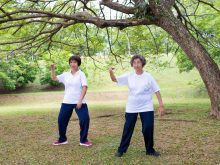Unexpected trips, stumbles and falls are major causes of injury risk for the vast majority of people, and the risk tends to go up as we age.
The passage of time does often come with a regression of things like balance, body awareness and control. Degeneration of joint structures, soft tissue and neurological ability physically are normal parts of aging, however, the rate of that degeneration can often be determined by a “use it or lose it” scale. The body is a master at adapting to its environments, and will keep prioritizing the abilities we need (and use) the most. Learning early what areas will help you stay active and spry, no matter your age, can help prevent degeneration to an extent that is hazardous to your physical ability and quality of life.
While fall prevention-based movements can be utilized by any age group, I begin recommending them to anyone over the age of 30 who is not otherwise actively engaging in whole-body, intentional movement. Intentional movement is movement that you are focusing in on as a specific task, and not movement that you do for routine work or chores where your mind might be on other things. Exercise is one form of intentional movement, but movement can be made intentional even if it isn’t in the context of a workout or time spent at the gym.
Read Also

Why not a Prairie sheep sector?
If Wales can raise 10 million sheep, why can the Prairies, at 100 times the area, only raise around 300,000? The demand for lamb is there, whether for domestic or export purposes, Ieuan Evans writes.
Some of the key areas to easily pay attention to when it comes to preventing trips and falls, start in the lower body — specifically the feet! Many falls start because we catch our foot on a raised surface, or lose our balance on uneven footing. Something as simple as a crack in the sidewalk, or thick carpet can be the precursor for a severe fall. If we increase our awareness to how our feet are meeting various surfaces, this can decrease the chance those surfaces catch us off guard.
One of the first things many people begin to lose is the ability to flex the ankle away from the ground. We also tend to have very little ability to move our toes independently from the foot, due to the amount of time we spend in shoes. These two things combined, lead to many people walking with the toes and forefoot closer to the ground, and therefore at a higher risk of catching the front or outside of their foot on various surfaces.
Try these four exercises on a routine basis to keep your ankle and foot moving. They take no more than a few minutes a day, and can prevent falls from impacting your stride. As a bonus, these exercises are also great for preventing and treating things like plantar fasciitis, fallen arches and flat feet. Do all these exercises without shoes on, in a safe environment, to build your awareness of the foot and its role in balance and gait.
- Slow-motion foot taps: Sit comfortably with your foot fully resting on the ground. Slowly raise your foot off the ground (keeping your heel planted). Ensure that you lift from the middle of your foot (so that your pinky toe and big toe raise levelly). Take about three to four seconds to raise up, and then slowly lower back to the ground. Do one foot and then the other foot. Repeat for 10 rounds per sides, a few times each day. Great warm-up prior to walks or runs!
- Toe curls: Sit comfortably with the feet resting on the ground. Keeping the foot on the ground, curl your toes into the ground. You could place a towel under your foot (spread out) and curl the toes into the towel to drag it in towards the foot. Curl the toes in and out 10 times. If using a towel, curl the towel in for 10 curls, then practise pressing it back out again using the toes (uncurling). You may feel like your arch of the foot muscles are working to do this; this is a good thing. Repeat daily, a few rounds where possible!
- Tandem walking: Take a step forwards placing one foot directly in front of the other (heel to toe). Walk forwards for 10 to 20 steps, stacking the feet as you go. Challenge yourself to look forwards (not at your feet) while doing this, and as an additional challenge walk backwards in this way to your starting point. Repeat daily, a few rounds where possible!
- Tiptoe walking: For 10 to 20 steps, walk as high as you can on your tiptoes. Work to keep your weight in the centre of the forefoot, and not more to the outside or inside edge of your foot as you walk. Try to walk in a straight line, sideways, and backwards like this. Challenge yourself to keep eyes up and looking ahead. Repeat daily, a few rounds where possible!
If falling is an issue for you, or you’re noticing a decrease in your balance ability, stability or motor awareness, it is important that you seek professional guidance to ensure the right plan of action to keep you moving sustainably, no matter your age. If you have pain that hasn’t changed over a few weeks or has occurred suddenly, please seek medical guidance before using these exercises as a regular tool.















